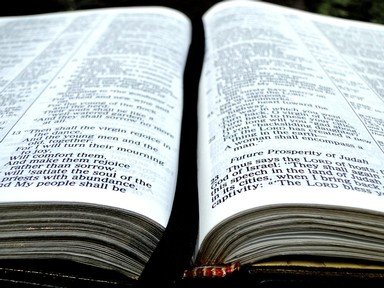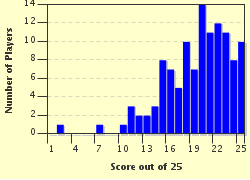Quiz Answer Key and Fun Facts
1. The letter 'A' is for 'Amen'. Using the KJV and the NKJV Bibles, the last word in the Gospel of Mark is 'Amen'.
2. The letter 'B' is for 'Blind'. The Gospel of Mark tells of Jesus healing a blind man outside Jericho. The man's name starts with the letter 'B'. Can you name him?
3. The letter 'C' is for 'Centurion'. According to the Gospel of Mark, a centurion is quoted as saying Jesus was "Truly... the Son of God." At what event did the centurion make the proclamation? (Mark 15:39)
4. The letter 'D' is for 'Deaf'. Mark 7:31-37 tells of Jesus miraculously healing a deaf man with a speech impediment. According to Scripture, Jesus put His fingers in the man's ears and spat and touched his tongue and after saying "be opened" the man was healed. In what community/area starting with the letter 'D' did the miracle take place?
5. The letter 'E' is for 'End of the Age'. In the Gospel of Mark, Jesus is quoted about signs regarding the end of the age. Which one below was NOT given by Jesus as a sign? (Mark 13:1-11)
6. The letter 'F'. The Gospel of Mark tells of Jesus causing a tree to wither because it was bearing no fruit. According to Mark 11:12-13, what type of a tree was it?
7. The letter 'G' is for 'Gentile.' According to the Gospel of Mark a Gentile woman persistently pleaded to Jesus to heal her daughter. In fact, Scripture suggests the Gentile woman wasn't prepared to go home until Jesus performed a miraculous cure. What was the Gentile woman's daughter suffering from? (Mark 7:24-30)
8. The letter 'H' is for 'Heaven'. In the Gospel of Mark, Jesus says heaven and earth will pass away, but one thing will never pass away. According to Mark 13:31, what will never pass away?
9. The letter 'I' is for 'Immediately'. Using the New King James Version Bible, the word 'immediately' appears more often in the Gospel of Mark than any other book in the Old Testament and the New Testament.
10. The letter 'J' is for 'Jesus'. Two of His better-known miracles involve calming a storm on the Sea of Galilee and feeding a multitude with a pittance of food. However, the Gospel of Mark states Jesus calmed two different storms on the Sea of Galilee and also fed two large gatherings of people on two different occasions.
11. The letter 'K' is for 'Kingdom of God'. In the Gospel of Mark, Jesus is quoted as saying it is difficult for the wealthy to enter the kingdom of God. What's the missing word from Mark 10:25 in the NKJV that contains the word kingdom: "It is easier for a _______ to go through the eye of a needle than for a rich man to enter the kingdom of God."
12. The letter 'L' is for 'Love'. Using the New King James Version Bible, the word love appears four times in Mark 12:30-32. The passage, quoting Jesus, states: "And you shall love the Lord your God with all your heart, with all your soul, with all your mind, and with all your strength. This is the first commandment. And the second, like it, is this: You shall love your neighbor as yourself. There is no other commandment greater than these." Who did Jesus make the statement to?
13. The letter 'M' is for 'Miracle'. Out of the four miracles listed below, one is recorded in only the Gospel of Mark. Do you know which one? (Mark 8:22-26)
14. The letter 'N' is for 'Naked'. Mark 14:51-52 tells of a young man fleeing naked after the arrest of Jesus. Is the naked man identified?
15. The letter 'O' is for 'Order'. In the order books appear in the New Testament, where does the Gospel of Mark appear?
16. The letter 'P' is for 'Parable'. Out of the four parables listed below, one is recorded in only the Gospel of Mark. Do you know which one?
17. The letter 'Q' is for 'Quiet'. According to Mark 1:40-45, Jesus performed a miraculous healing and then told the person to remain quiet and not tell anyone.
18. The letter 'R' is for 'Relative'. According to the Gospel of Mark, Jesus healed a relative of Peter, one of the Twelve Disciples. Who was the relative? (Mark 1:29-31)
19. The letter 'S' is for 'Seven'. According to the Gospel of Mark, Jesus drove seven demons out of a woman. What was her name? (Mark 16:9)
20. The letter 'T' is for for 'Touching'. According to the Gospel of Mark, a large number of people were cured by simply touching Jesus.
21. The letter 'U' is for 'Unclean Spirit'. Mark 1:21-28 tells of Jesus meeting up with a man with an unclean spirit in a synagogue. According to the passage, how did Jesus miraculously drive out the unclean spirit from the man?
22. The letter 'V' is for 'Vain'. The Gospel of Mark quotes Jesus using verses from the Old Testament while addressing the Pharisees. The verses, found in Mark 7:6-7, contain the word 'vain':
"This people honors Me with their lips,
But their heart is far from Me.
And in vain they worship Me,
Teaching as doctrines the commandments of men."
Whereabouts in the Old Testament do you find the verses Jesus is quoted as using?
23. The letter 'W' is for 'Withered'. The Gospel of Mark tells of Jesus healing a man with a withered hand. Scripture states the Pharisees were so upset about the healing they began plotting to kill Him. What, according to Mark 3:2, incensed them about the healing?
24. The letters 'X' and 'Y' is for 'Years'. The Gospel of Mark tells of a woman with a bleeding problem being cured immediately after she secretly touched Christ's gown. According to Mark 5:25, how many years had she had the bleeding problem?
25. The letter 'Z'. The Gospel of Mark tells of Jesus calling on two brothers, James and John, who were fishermen to follows Him. According to Mark 1:19, what was their father's name?
Source: Author
Cowrofl
This quiz was reviewed by FunTrivia editor
agony before going online.
Any errors found in FunTrivia content are routinely corrected through our feedback system.

